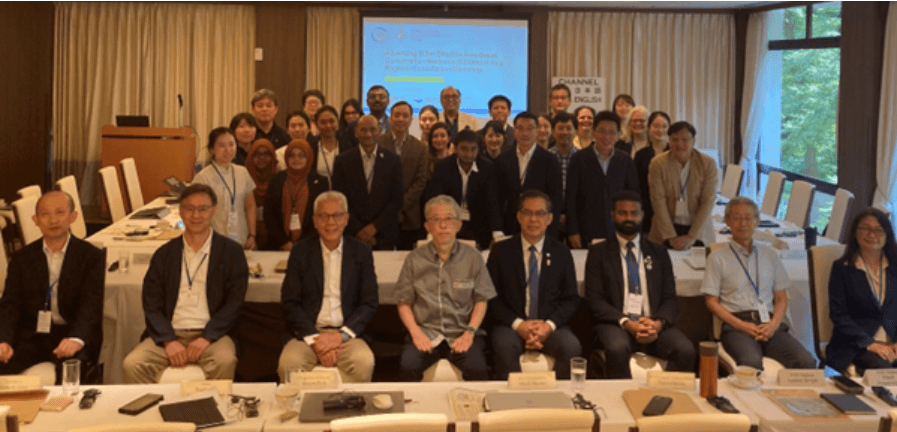Nature, culture, and commitment: Asia's journey to 30x30 through OECMs
In July 2024, IUCN led the organisation of two workshops focusing on other effective area-based conservation measures (OECMs). Held in Tokyo and Seoul, the consecutive workshops provide a unique opportunity for government and NGO representatives across Asia to report on and share best practices on mainstreaming OECMs.

Understanding OECMs
OECMs, or other effective area-based conservation measures, are defined as areas outside of traditional protected areas that achieve long-term biodiversity conservation, including associated ecosystem functions, services, and, when applicable, cultural, spiritual, socio-economic, and other locally significant values. These can include community-managed lands, privately conserved areas, indigenous territories and areas under sustainable use that provide significant biodiversity benefits. OECMs must be linked and integrated with broader landscapes to provide ecological functionality integrity and structural connectivity to wider land and seascapes. The recognition of OECMs is crucial for achieving the global goal of protecting and conserving 30% of the world's terrestrial and marine areas by 2030, known as the 30x30 target, established under the Kunming-Montreal Global Biodiversity Framework (GBF). As of July 2024, there are 881 OECMs reported globally in the World Database on OECM (and they only represent 1.29% of global protected and conserved areas' coverage).
Tokyo: setting the stage for regional collaboration on OECMs
The first stop was Tokyo, where the APAP Regional Consultation Workshop on OECMs took place from 8 to 9 July 2024. Hosted by the Ministry of Environment of Japan, the dialogue was organised by the Asia Protected Areas Partnership (APAP) and IUCN Asia Regional Office with strong support from the IUCN Global Protected and Conserved Areas and WWF. These meetings brought together government officials, conservationists, and experts from across Asia to share knowledge, forge new connections, and build a common pathway to contribute to the 30x30 Target. Country representatives from Bangladesh, China, India, Indonesia, Japan, the Republic of Korea, Maldives, Thailand and Viet Nam were present, as was a representative from the ASEAN Centre for Biodiversity (ACB).
The common interest was shared as participants gathered to discuss the integration of OECMs into their national strategies. The workshop began with welcoming addresses from the Ministry of Environment of Japan (MOEJ) and APAP leaders, emphasising the importance of OECMs in conserving 30% of terrestrial and marine areas by 2030.
Throughout the two days, representatives from various countries presented their progress and challenges in implementing OECMs. Discussions about strategies, successes, and lessons learned were conducted. The highlight was a series of presentations showcasing efforts in each country. All representatives shared diverse progress and approaches tailored to the needs and capacities of their countries.
The Tokyo workshop concluded with a strong sense of collaboration and a commitment to continue these efforts. A roadmap is being prepared to share regional strategies that APAP member countries can use to support their OECMs pathway. The outcomes of the discussions are set to be shared at the 8th IUCN Asia Regional Conservation Forum in September 2024 and the upcoming CBD COP16 in October 2024, ensuring that the knowledge gained would contribute to global conservation efforts.
Asia Protected Areas Partnership (APAP)
The Asia Protected Areas Partnership is playing a significant role as a critical platform to help governments and other stakeholders collaborate for more effective management of protected and conserved areas in the region. The partnership was initiated in 2013 at the first-ever Asia Parks Congress held in Japan, and formally launched the following year at the IUCN World Parks Congress in Australia. This year, the partnership is poised to celebrate a significant milestone – its decade of collaboration - and take another step forward to achieve Target 3.
The need for collaboration and unity among various stakeholders, from local communities to international bodies, was repeatedly highlighted during the meeting. This approach fosters a collective responsibility towards conservation and promotes an inclusive approach where diverse groups can contribute to and benefit from sustainable practices. As Dr Dindo Campilan, Co-Chair of the APAP and IUCN Regional Director for Asia and Hub Director for Oceania mentioned, "OECMs will contribute to 30x30, but there may be potential of OECMs beyond 30x30, feeding into the whole GBF. Let's build bridges, let's build a community."
Japan's progress under the national 30x30 roadmap
As a host of the regional consultation meeting, the Ministry of Environment of Japan shared how it has established a national roadmap that outlines necessary actions to achieve the 30x30 target with the help of relevant ministries. With support from a multi-stakeholder platform, "the 30by30 Alliance for Biodiversity," which includes members from businesses, local governments and NGOs, Japan started to certify "Nationally Certified Sustainably Managed Natural Sites" in 2023. Under the certification system, 184 sites had been certified as of February 2024 as sites that contribute to biodiversity conservation through private entities' initiatives.
On 9 July 2024, workshop participants concluded their regional meeting with a visit to 'Doyatsu-no-sato' in Chiba Prefecture, where the non-profit organisation NPO Balance 21 is actively restoring a ‘Satoyama’ and conserving biodiversity in the area. Satoyama consist of production ecosystems like secondary forests, farmlands, irrigation ponds, and grasslands as well as human settlements. They are created by continuous human interventions, and eventually become irreplaceable habitats for a range of fauna and flora. The conservation of biodiversity in the area is therefore inseparable from human activities.
The participants learned about the conservation efforts made through collaboration among landowners, the local government and other conservation actors. Japan is further strengthening its efforts by enacting a new law in April 2024, "the Act on Promoting Activities to Enhance Regional Biodiversity," which promotes voluntary activities by the private sector.
"Mr Mitsuo Wada, MOEJ, introducing the OECM site with NPO Balance 21 and officers from the local government" © IUCN / Kosuke Terai
Workshop participants experience first-hand the OECM site 'Doyatsu-no-sato'“© IUCN / Siska Sihombing
Seoul: showcasing the RoK experiences on OECMs
Just a few days later, from 11 to 12 July 2024, supported by IUCN Global Protected and Conserved Areas team, the Korea National Park Service (KNPS) hosted a national dialogue on OECMs to celebrate their progress in the Republic of Korea, also discussing the potential of the IUCN Green List to monitor and enhance the effectiveness of OECMs. The consultation was part of a project titled "Guiding National and Regional Contributions to the New Global Biodiversity Framework through Effective Systems of Protected and Conserved Areas in the Republic of Korea and Asia", which has been active since February 2022. With support from the Ministry of Environment of the Republic of Korea and led by IUCN Protected and Conserved Areas, this project aims to support the Republic of Korea on area-based conservation effectiveness in Korea and Asia.
Building on the Tokyo workshop’s momentum, the Seoul event provided a platform for discussing practical applications of global guidance on OECMs tailored to the Korean context and of national roadmap for OECMs in the Republic of Korea.
Participants came from key groups involved in OECMs' work at the national level, such as the Ministry of Environment, Korea Protected Areas Forum (KPAF) and the Korean Green List EAGLs (Expert Assessment Group for the Green List). The EAGL adapts the global Green List Standard to the jurisdictional context and evaluates and assesses protected and conserved areas that apply to be added to the Green List. The workshop started with sessions highlighting the progress made in the Republic of Korea and other Asian countries, subsequently discussing national strategies and pilot applications of OECMs.
All participants of OECMs workshop in the Republic of Korea" © IUCN / Saebyeol Seo
The participants also suggested the opportunities for the IUCN Green List Standard to monitor and enhance the effectiveness of OECMs. The Standard includes 4 components: Good Governance, Sound Design and Planning, Effective Management, and Successful Conservation Outcomes. It can be helpful in monitoring the outcomes of OECMs. Some relevant case studies in South Korea will be explored further.
A field visit to Seoul Forest Park was a feature of the Seoul workshop. Opened to the public in 2005, this urban oasis spans 150,000 square metres and features themed areas such as the Ecological Forest, Culture and Art Park, and Wetlands Ecological Park. The visit to the Ecological Forest was particularly inspiring, as it demonstrated a natural habitat supporting local wildlife. This site is a candidate for OECM recognition in the country.
A site visit to the Seoul Forest Park" © IUCN / Saebyeol Seo
Continuing the efforts to recognise Korea's OECMs: started from Cheorwon
In 2022, South Korea recognised nationally their first OECM site in Cheorwon. The recognition highlights the importance of integrating cultural and natural heritage in conservation. It is an inspiring example of how conservation can be community-driven, culturally respectful and ecologically effective. The area is particularly famous for being a sanctuary for migratory birds, including the Red-Crowned and White-Naped Cranes. The local community has played an important role in preserving these habitats, showcasing how traditional culture and efforts strongly align with national and global conservation goals.
Strong partnership with IUCN
The IUCN Asia Regional Office and the IUCN Global Protected and Conserved Areas played essential roles in these meetings. IUCN provides support and guidance, capacity-building activities, and promoting countries' case studies at global policy events and meetings. IUCN's World Commission on Protected Areas (WCPA) offered guidance on identifying, recognising, and reporting OECMs, ensuring effective biodiversity conservation beyond traditional protected areas. The dialogues in Tokyo and Seoul underscored the significance of OECMs, highlighting the diverse approaches and successes across Asia.
As countries in Asia continue to identify and support OECMs, the collective goal of conserving 30% of the world's terrestrial and marine areas by 2030 becomes increasingly attainable. The shared knowledge, partnerships and the upcoming roadmap resulting from these meetings will contribute further to global conservation efforts.
Disclaimer
Opinions expressed in posts featured on any Crossroads or other blogs and in related comments are those of the authors and do not necessarily reflect the opinions of IUCN or a consensus of its Member organisations.
IUCN moderates comments and reserves the right to remove posts that are deemed inappropriate, commercial in nature or unrelated to blog posts.



